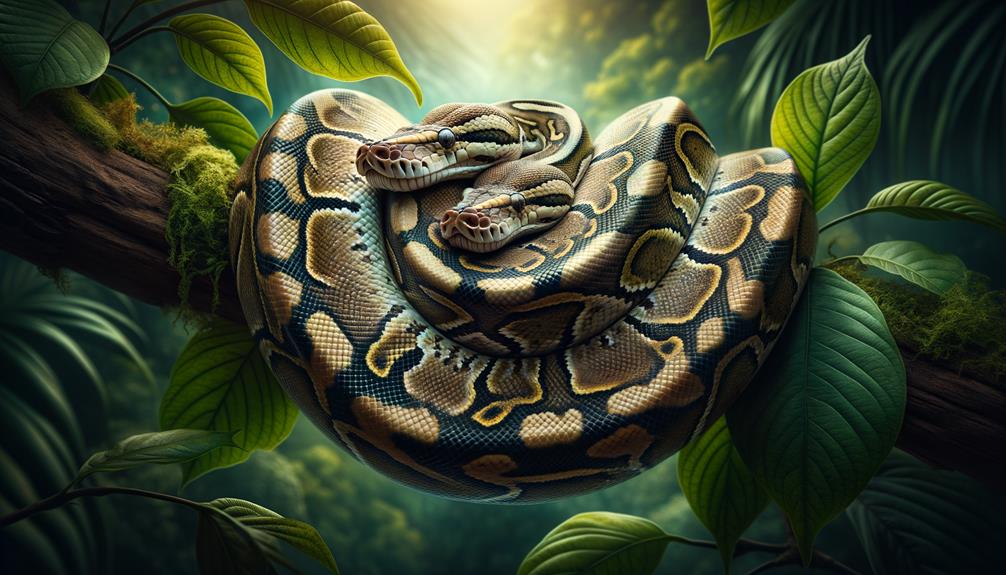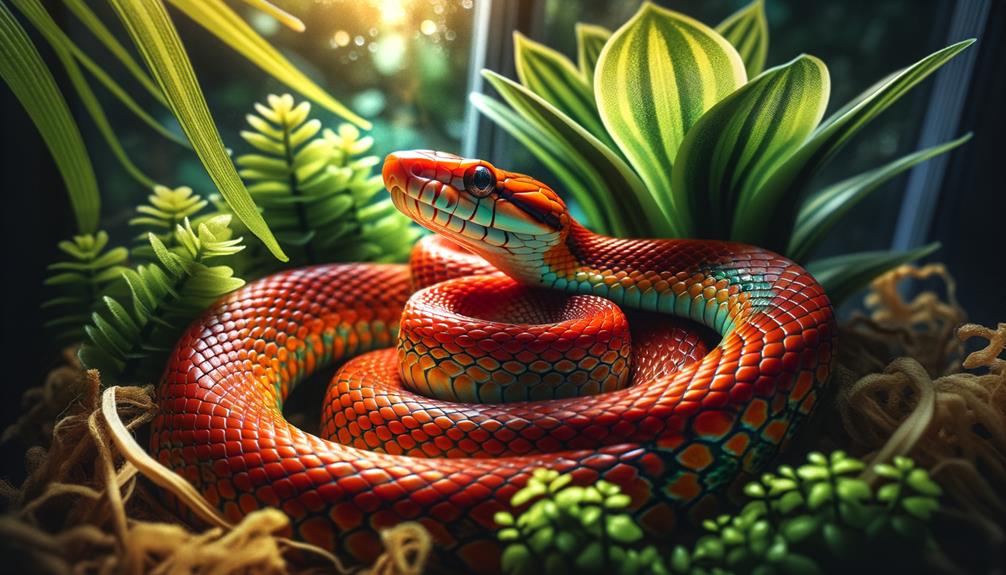I’m captivated by the vibrant color variations of kingsnakes. The Eastern kingsnake‘s striking chain-like pattern of white or yellow bands on a dark background allows them to blend seamlessly into their habitats. California kingsnakes display an incredible array of colors, ranging from pure white to lavender, and even feature unique morphs like reverse stripes. Black kingsnakes are another wonder, with dark bodies adorned with distinctive white or yellow spots and bands that vary geographically. There’s also the albino kingsnake, which sports striking white or yellow patterns and bright red eyes. Juvenile kingsnakes exhibit intense colors that are essential for their survival. What makes their adaptability so remarkable?
Key Takeaways
Kingsnakes showcase a stunning array of colors, ranging from pure white to lavender and banana patterns. The Eastern kingsnake features a distinctive chain-like pattern, with white or yellow bands on a dark brown or black background. California kingsnakes boast an impressive variety of morphs, including reverse stripes and vanishing stripes. Black kingsnakes exhibit unique geographic variations, characterized by dark bodies adorned with white or yellow spots. Albino kingsnakes, on the other hand, display striking white or yellow patterns, accompanied by bright red eyes due to albinism.
Eastern Kingsnake Patterns
The Eastern kingsnake‘s striking chain-like pattern of white or yellow bands on a dark brown or black background creates effective camouflage in its native habitats. Found throughout the eastern United States, from Florida to New York, these snakes blend seamlessly into their surroundings. The alternating black bands and lighter stripes form a chain pattern that not only helps them remain unseen by predators but also provides protection through mimicry.
This mimicry involves the kingsnake’s resemblance to venomous coral snakes, a defense mechanism that deters potential attackers. While the Eastern kingsnake is non-venomous, the visual similarity to its dangerous counterparts is often enough to discourage predators. The contrast between the white or yellow bands and the dark background plays a vital role in their survival.
In the wild, the Eastern kingsnake’s distinct color patterns serve multiple purposes. The camouflage provided by the chain pattern allows them to navigate their habitats with relative safety. Meanwhile, the mimicry of venomous coral snakes offers an additional layer of defense, showcasing the ingenuity of nature in the art of survival.
California Kingsnake Colors
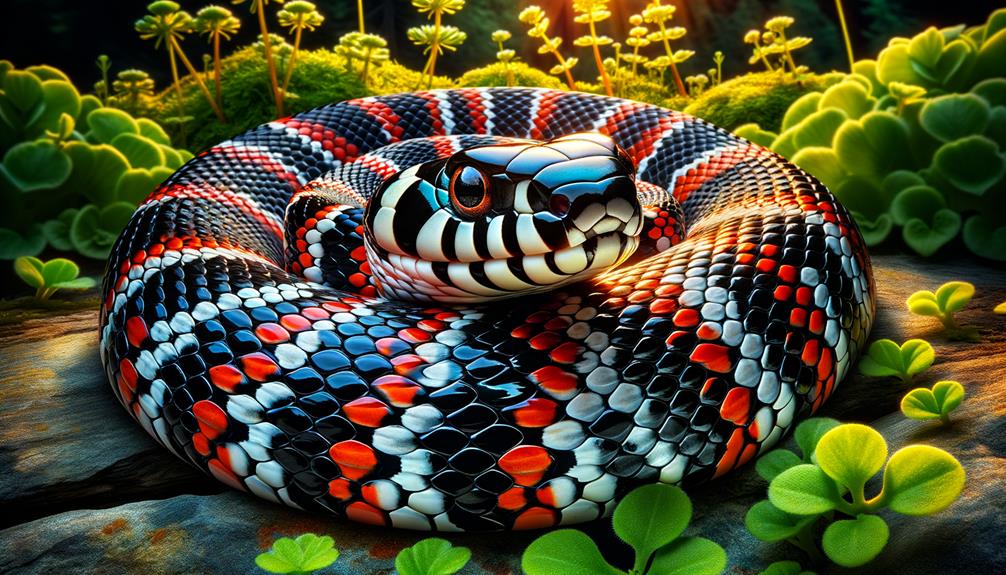
California kingsnakes boast an incredible array of colors, ranging from pure white to lavender and banana patterns, with twin stripes and more. The natural diversity of these snakes is truly remarkable. The various morphs, such as reverse stripes, vanishing stripes, and charcoal backs, add even more variety to their vibrant palette. Each unique pattern tells a distinct story of adaptation and beauty.
In their coastal habitats, California kingsnakes display yellow and brown hues, blending seamlessly with their surroundings. In contrast, desert-dwelling kingsnakes exhibit striking black and white coloration. This adaptability across different environments is a testament to the species’ remarkable flexibility.
Breeding specific morphs, like the Palomar ghost and dark phase ghost, presents both challenges and opportunities. These ghost morphs, including platinum and Casper ghost, offer enthusiasts a chance to explore unique color patterns. Breeding efforts can result in fascinating new combinations that push the boundaries of what is understood about these snakes.
The intricate interplay of genetics and environment produces a stunning array of colors, making the California kingsnake a true marvel of nature. It’s a reflection of the boundless potential found in the natural world.
Black Kingsnake Markings
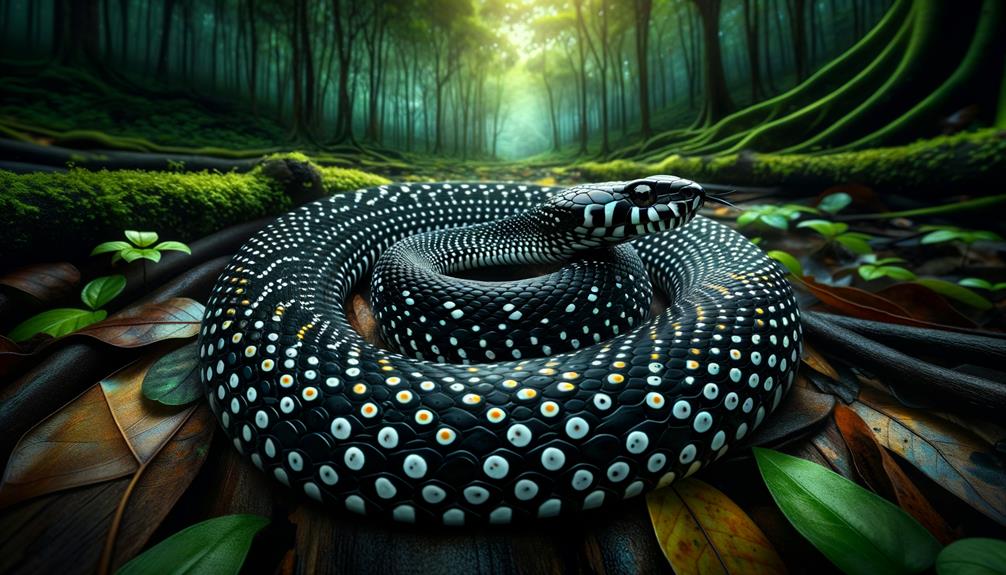
When examining the unique pattern features of black kingsnake markings, I find it fascinating that no two snakes have the exact same arrangement of bands and spots. These variations often differ geographically, suggesting a potential evolutionary adaptation to their specific environments. By studying these distinctions, we can gain a deeper appreciation for these reptiles and uncover insights into their survival strategies.
Unique Pattern Features
Black kingsnakes are a sight to behold, with their dark bodies adorned with white or yellow spots and bands, creating a remarkable camouflage. This unique pattern serves a vital purpose in the wild, allowing them to blend seamlessly into their surroundings, whether it’s rocky terrain, dense forests, or open grasslands.
When examining a black kingsnake, several distinct physical characteristics stand out:
- Sleek Scales: Their smooth, glossy scales contribute to their streamlined appearance, enhancing their vibrant patterns.
- Distinctive Eyes: Their round pupils give the snake a distinct look, making it easier to identify kingsnakes.
- Unique Head Shape: The spoon-shaped head is well-suited for burrowing and hunting activities.
- Intricate Markings: The chain-like patterns are a hallmark of the species, creating a striking visual effect that also serves as effective camouflage.
The combination of these features – sleek scales, distinctive eyes, a unique head shape, and intricate markings – makes the black kingsnake an exceptional example of nature’s craftsmanship. Their ability to thrive in varied environments across North America is a testament to their adaptability and the effectiveness of their camouflage.
Geographic Color Differences
The unique pattern features of black kingsnakes are fascinating, especially when you consider how their markings vary across different geographic regions. In areas like Florida or the eastern U.S., black kingsnakes often exhibit striking white markings – spots or bands that stand out against their dark bodies. These regional color differences aren’t random; they’re influenced by factors like habitat and genetic diversity.
In contrast, some populations might show a more uniform black coloration, lacking any white markings altogether. This variation in color patterns is a clear sign of the evolutionary adaptations these snakes have developed over time. Genetic diversity within black kingsnake populations plays a significant role in these color variations, allowing them to adapt to specific environmental conditions.
The distribution patterns of these snakes also highlight the impact of geographic isolation. Regions separated by natural barriers can lead to distinct color variations as populations evolve independently. By studying these geographic color differences, we gain valuable insights into how habitat influences and evolutionary pressures shape the physical characteristics of black kingsnakes. It’s a vivid demonstration of nature’s complexity and the freedom of life to adapt and thrive in diverse environments.
Evolutionary Adaptations Explained
In examining the evolutionary adaptations of black kingsnake markings, it’s clear that their striking coloration serves as a highly effective survival strategy. The nearly black body adorned with white or yellow spots and bands allows these snakes to seamlessly blend into various habitats. This camouflage is crucial for their survival, making it harder for predators to spot them.
Moreover, these vibrant color variations are not just for hiding. The contrasting colors mimic venomous species like coral snakes, which serves as a defense mechanism. This resemblance can confuse and deter potential threats, increasing the black kingsnake’s chances of survival.
Key points about their evolutionary adaptations include:
- Camouflage: The dark body with contrasting spots and bands helps them blend into different environments, reducing visibility to predators.
- Mimicry: By resembling venomous snakes like coral snakes, their color patterns serve as a visual warning to potential predators.
- Defense Mechanisms: The striking markings can startle and confuse predators, giving the kingsnake a chance to escape.
- Ecological Success: These adaptations have contributed to the black kingsnake’s survival strategies, ensuring their ecological success in diverse habitats.
Clearly, these color patterns are vital for the black kingsnake’s survival. Their unique markings have evolved to provide a strong defense against predators, allowing them to thrive in their environments.
Albino Kingsnake Traits
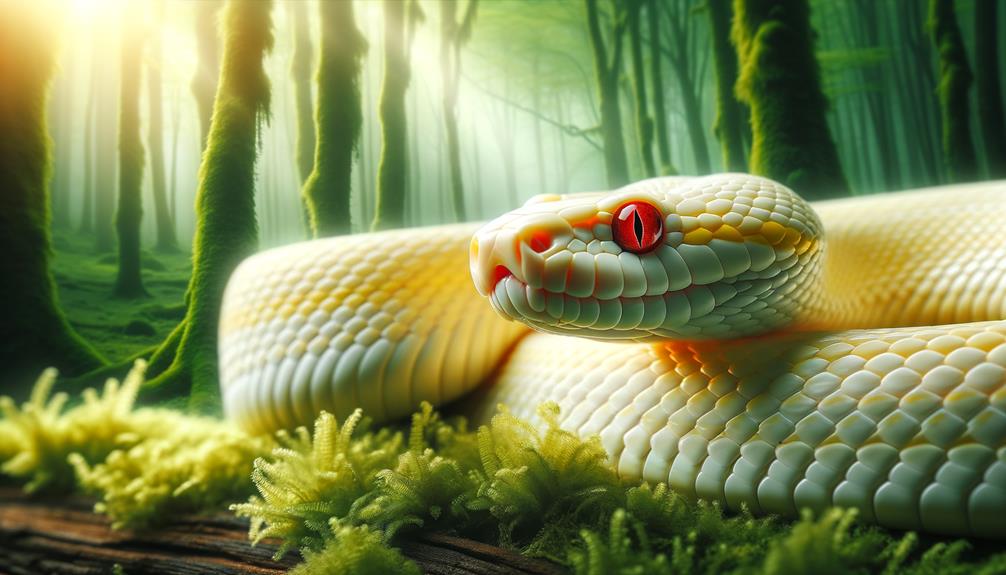
When I observe albino kingsnakes, their striking appearance immediately grabs my attention. The lack of melanin creates a stunning white or yellow pattern, and their bright red eyes are unmistakable. This unique visual trait is not only a result of a genetic mutation but also a major factor in their popularity among reptile enthusiasts. I’ll delve into the specifics of their color patterns, the genetic causes behind albinism, and what makes caring for them relatively easy.
Distinct Color Patterns
Albino kingsnakes, with their striking white or yellow patterns and pink or red eyes, have captivated both enthusiasts and scientists with their unique appearance. This genetic mutation eliminates melanin pigmentation, resulting in a stunning contrast that’s impossible to ignore. Their vibrant coloration is not only visually striking but also a significant factor in their popularity in the pet trade.
When observing albino kingsnakes, several distinctive traits stand out:
- Vivid Color Patterns: The lack of dark pigments produces bright white or yellow patterns that are visually striking.
- Eye Color: The absence of melanin affects their eyes, giving them a pink or red hue that’s both fascinating and unusual.
- Unique Pattern: Each albino kingsnake displays a one-of-a-kind pattern, ensuring no two snakes look exactly alike.
- Genetic Rarity: The genetic mutation responsible for their pigmentation results in an exotic and rare appearance, adding to their allure.
These characteristics have made albino kingsnakes a favorite among collectors and researchers, who admire their extraordinary beauty and the genetic wonder that creates such a distinctive look.
Genetic Mutation Causes
Understanding the stunning appearance of albino kingsnakes begins with examining the genetic mutation that affects melanin production. This mutation leads to a unique palette of white or yellow scales and vibrant red or pink eyes. The absence of melanin doesn’t just impact their color; it fundamentally alters their biology.
Albino kingsnakes are a marvel of nature, but their vibrant coloration comes with a trade-off. In the wild, their lack of camouflage makes them more visible to predators, increasing their vulnerability. However, this same trait makes them highly sought-after in the pet trade. Their striking appearance is a result of the genetic mutation that influences not only their coloration but also their skin and scales.
These snakes require special care to thrive in captivity. Their skin sensitivity necessitates protection from UV light to prevent damage and maintain their health and color vibrancy. This genetic mutation makes albino kingsnakes a testament to the wonders of nature, fascinating reptile enthusiasts and collectors alike. The allure of their vibrant colors and distinctive red or pink eyes continues to fuel their popularity, despite the extra care they require.
Care Requirements Overview
Caring for albino kingsnakes requires attention to their unique sensitivity to light, ensuring their enclosures are dimly lit to protect their skin. These striking creatures, with their white or yellow coloration and pink or red eyes, need special care to thrive in captivity. As popular pets, their health and well-being should be a top priority.
Key care requirements for albino kingsnakes include:
- Dim Lighting: Since albino kingsnakes lack melanin pigment, they’re more prone to sunburn. Use low-intensity lighting and avoid direct sunlight to prevent skin damage.
- UVB Lighting Precautions: While some UVB exposure is beneficial, it should be minimal and carefully monitored. Overexposure can lead to severe skin conditions.
- Regular Monitoring: Keep a close eye on their skin condition and behavior. Address any signs of distress or skin abnormalities promptly to safeguard their health and well-being.
- Appropriate Enclosure Setup: Provide a variety of hides and climbing areas to mimic their natural habitat, ensuring they have a comfortable environment to explore and retreat.
Juvenile Kingsnake Variations
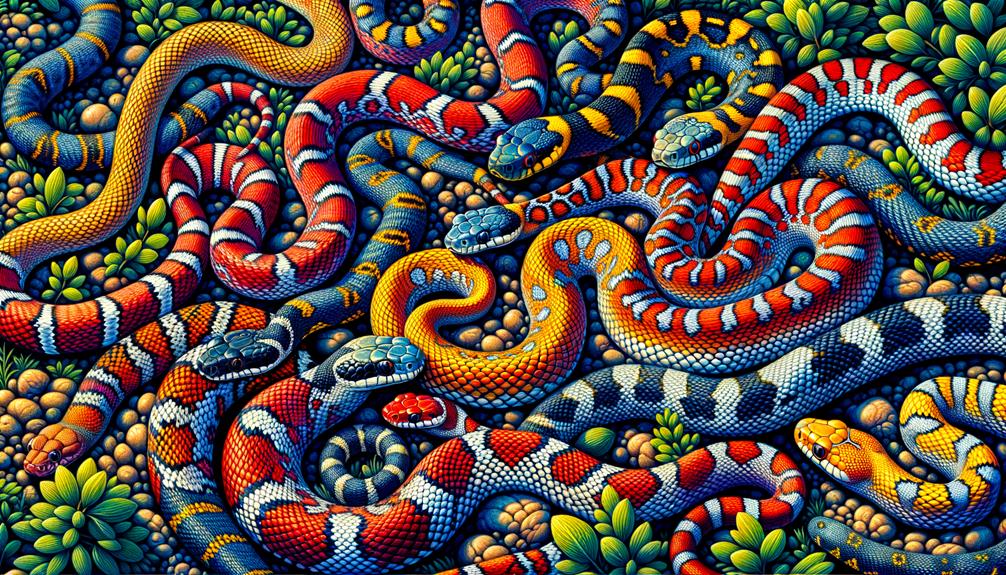
Juvenile kingsnakes boast some of the most striking color patterns in the reptile world, featuring vibrant bands of red, yellow, and black. These colors serve a vital purpose, playing a crucial role in the snake’s survival. The bold patterns, which can include bands, blotches, or stripes, are essential for camouflage and mimicry.
In diverse populations, juvenile kingsnakes exhibit unique morphs, such as high white, lavender, or reverse striped patterns, that set them apart. These variations not only help the snakes blend into their surroundings but also mimic more dangerous species, deterring potential predators. As the juveniles grow, their colors and patterns often intensify or change, showcasing the remarkable diversity within kingsnake populations.
It’s fascinating to observe how these young snakes adapt their appearances for better survival. Their striking color patterns are not just for show; they’re integral to their way of life, demonstrating nature’s ingenuity in ensuring the continued existence of these remarkable reptiles.
Habitat and Adaptation
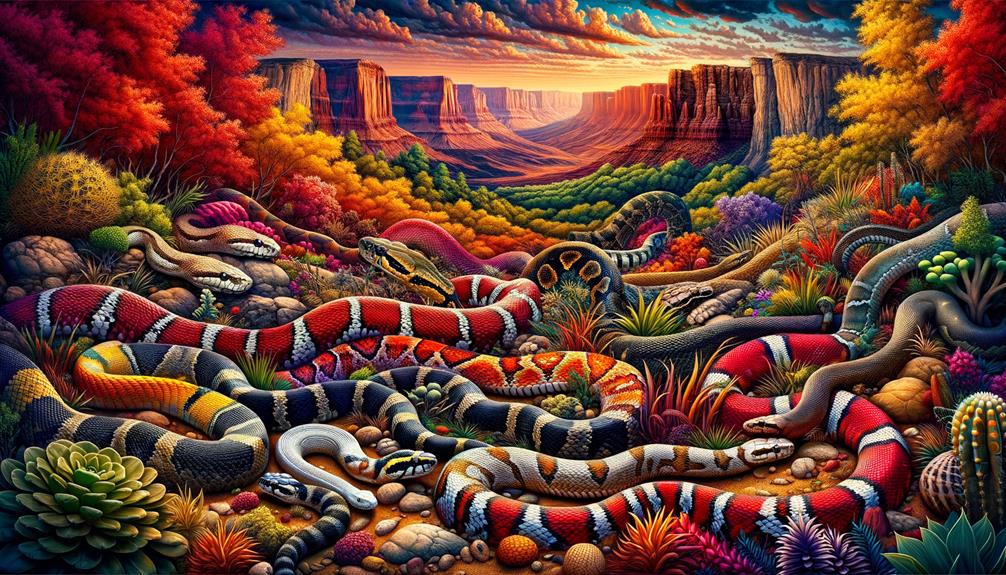
As juvenile kingsnakes mature, their vibrant colors evolve, and their remarkable adaptability to diverse habitats becomes evident. These snakes thrive in a variety of environments across North America and into Mexico, showcasing their evolutionary success. From tropical forests and shrublands to rocky areas, suburbs, and deserts, their ability to inhabit such diverse habitats is remarkable.
The color variations in kingsnakes play a crucial role in their survival strategies. They range from muted browns to vibrant whites, reds, yellows, grays, and even lavenders. These color variations serve as effective camouflage, allowing kingsnakes to blend seamlessly into their natural surroundings. Camouflage isn’t just about hiding from predators; it also aids in hunting, enabling them to ambush prey with stealth.
Consider these fascinating aspects of their habitat and adaptation:
- Tropical Forests: In tropical forests, their vibrant colors help them blend among colorful foliage and dappled sunlight.
- Deserts: In desert environments, muted browns and grays offer camouflage against sandy and rocky landscapes.
- Suburbs: Kingsnakes’ flexibility in color allows them to adapt to human-altered environments.
- Rocky Areas: Patterns and hues mimic the rocky terrain, providing excellent concealment.
These survival strategies underscore the kingsnake’s evolutionary success, making them an intriguing subject for those who value the freedom of nature’s adaptability.
Frequently Asked Questions
What Are the Color Variations of Kingsnakes?
I find kingsnakes fascinating due to their diverse color variations, ranging from vibrant whites, reds, yellows, grays, and lavenders to muted browns. Their striking patterns and hues make identifying them a thrilling challenge for any enthusiast.
Why Is the California Kingsnake Brightly Colored?
California kingsnakes have evolved to display bright colors as a defense mechanism, mimicking other venomous snakes to deter predators. Their vibrant patterns, shaped by natural selection, help them blend into varied habitats and avoid threats, ultimately ensuring their survival and evolutionary success.
What Is the Best Looking Kingsnake?
The tyranny of choosing the best-looking kingsnake! In my opinion, the California kingsnake’s Palomar Ghost morph takes the crown. Its otherworldly coloration and rarity make it a stunning, almost rebellious, spectacle of nature’s artistry.
What Is the Color Pattern of a King Snake?
I find the color pattern of a king snake fascinating; it varies from vibrant hues like reds, yellows, and whites to muted tones like browns and grays, often featuring bands or stripes. What’s intriguing is that these patterns can even mimic those of venomous species, adding to their allure.


